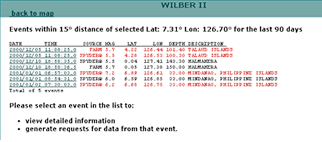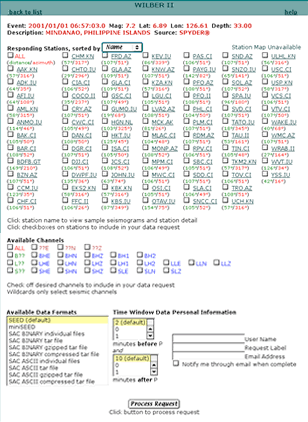POND and WILBER II: Transition to a more dynamic event dataset
An initiative was put forth in the Summer of 2000 to rebuild the FARM system, which is IRIS DMC’s readily-accessible seismic event data repository. The problems that plagued the FARM were an out-of-date or incomplete accounting of station data, old or incorrect metadata headers, and data mostly being from GSN stations.

interface – Map display.
The goal was a system that could more easily be updated as station data became available from many networks and where updates in station metadata would not require time-consuming rebuilds of hundreds of SEED files. The result was a design called “POND”, which is an acronym for “Pool Of Network Data”. The scheme would involve breaking the FARM data into pieces, each of which could be easily modified or appended to as needed. (One POND holds all the data for one seismic network.)
The primary piece is the waveform data itself, which would leave the static confines of the SEED volume and instead reside on disk in the form of miniSEED. The metadata, which was in the SEED header, would now instead be obtained from the Oracle database.
This separation will allow the DMC to make updates to the data simply by appending it to the proper miniSEED file on disk and make updates to the metadata simply by changing database entries. In this way, POND succeeds in being a more flexible format for event data.
Because of the changes enacted here, the WILBER system, which was intertwined with the FARM format, would have to be changed. Initially planned as merely an adaptation of the original system to the POND data format, it soon evolved into an entirely new software entity, with just some amount of resemblance to its ancestor. This new utility, which interfaces with POND event data, has been named WILBER II, in the tradition of sequels.
What WILBER II brings to users is not only access to data that is more up-to-date and complete, but also a leaner, more efficient event browsing interface.

interface – Events within a specified region.
What users familiar with the original WILBER will first notice is that WILBER II no longer uses HTML frames for separating sections. This has been replaced with progressive pages that the user steps through to narrow down their selection to a single event. Interactivity is also enhanced by the use of Javascript triggers in many of the selection boxes, so that a user does not have to press a submit button after making a selection change. Selecting a different quarter and year on the event map page, for instance, will cause the map to automatically change.
Another new feature of WILBER II is the event list selection. On the original system, clicking on a part of the event map returned events covering a 60 degree square block, which covers a rather large area. WILBER II now uses a radius selection feature, where the user selects a radius in degrees and then clicks on a region of interest on the map.
What results is a return of events within the selected degree distance from where the user selected. This allows the user to make more confined selections to easily narrow down the event they are interested in. As well, there is an option to simply list all events for that quarter and year.
At the top of the event page is a summary of the event being examined, followed by a table of available stations. Just above the table is a selection tool that allows the user to sort the station table by station name, network code, or distance from the event. Also above the station table is a link to a display of responding stations on a world map.

interface – Download data from stations for an event.
Each station entry consists of a check-box, a footnote of distance and azimuth from the event, and an anchor to bring up sample waveform plots for that station. By selecting the anchor, a pop up window presents the user not only plots of the station’s waveform data, but also information about the station itself, as well as a link to the online FDSN station book, should an entry be found. By selecting the check-box, the user includes that station in their data request from POND.
Below the station table is a channel table, which represents a unique list of all the channels available for request from POND. Selecting a checkbox next to a channel or channel wildcard adds it to the request.
At the bottom of the page are additional tools for rounding out a request for data. First, on the left-hand side is a list of data types that WILBER II can produce. The user selects one of these and then proceeds to the time windowing tools, which set the approximate time window of data before the P-wave and after the P-wave in minutes. The last step to making the data request is to fill out the user name and label fields. The email field is optional, and is used for tracking purposes at IRIS DMC. The additional email entry feature is if the checkbox below it is activated: WILBER II will now send email notification when processing of your request is finished.
What happens behind the scenes as a request is being processed is in POND’s arena. In order to provide the user with the most updated representation of data, POND must assemble a new data product from scratch. By using the miniSEED data in the POND archive, and information available in the Oracle database, POND is capable of constructing output products such as miniSEED, full SEED, SAC, SAC_ASCII, and bundled versions of SAC and SAC_ASCII, all based on the user’s request selections.
WILBER II and POND, working together, help the IRIS DMC realize its goal of presenting a more dynamic data presentation to the scientific community. As POND matures, users can be assured to get the latest data sets for a given event with the most up to date meta data representations in their requested data products. WILBER II, with its cleaner interface design, makes event browsing even easier and more productive than was previously provided.
The state of these two projects is nearing beta-testing stages, where the interface will be publicly presented and available for testing and comment. A working system exists already, but it has taken some time to rebuild the FARM into the POND format, and so it is hoped that users will be able to access WILBER II by Summer 2001.
by Rob Casey (IRIS Data Management Center)






